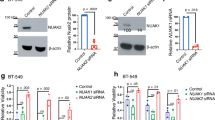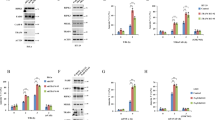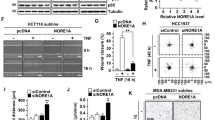Abstract
The tumor necrosis factor (TNF) receptor family are ligand-regulated transmembrane proteins that mediate apoptosis as well as activation of the transcription factor NF-κB. Exogenous expression of DR6, a recently identified member of the TNF receptor family, induced apoptosis in untransformed or tumor-derived cells and the apoptotic function of DR6 was inhibited by co-expression of Bcl-2, Bcl-xL or the inhibitor-of-apoptosis (IAP) family member, survivin. Expression of a dominant negative mutant of FADD failed to protect from DR6-mediated apoptosis indicating that unlike TNFR1 and Fas, DR6 induced apoptosis via a FADD-independent mechanism. Despite the ability of exogenous DR6 expression to induce apoptosis, DR6 mRNA and protein were found to be elevated in prostate tumor cell lines and in advanced stages of prostate cancer. Analysis of several anti-apoptotic proteins revealed that Bcl-xL levels and serine 32 phosphorylation of IκB, the natural inhibitor of NF-κB, were similarly elevated in cells expressing high levels of DR6, suggesting that NF-κB-regulated survival proteins may protect from DR6-induced apoptosis and that DR6 is a target of NF-κB regulation. Treatment of LnCAP cells with TNF-α resulted in increases in both DR6 mRNA and protein levels, and this induction was suppressed by inhibitors of NF-κB. Similarly, treatment of cells expressing high levels of DR6 with indomethacin and ibuprofen, compounds also known to perturb NF-κB function, resulted in a dose-dependent decrease in DR6 protein and mRNA levels. These results demonstrate that TNF-α signaling induces the expression of a member of its own receptor family through activation of NF-κB.
This is a preview of subscription content, access via your institution
Access options
Subscribe to this journal
Receive 50 print issues and online access
$259.00 per year
only $5.18 per issue
Buy this article
- Purchase on Springer Link
- Instant access to full article PDF
Prices may be subject to local taxes which are calculated during checkout





Similar content being viewed by others
References
Baeuerle PA, Baltimore D . 1996 Cell 87: 13–20
Beg AA, Baltimore D . 1996 Science 274: 782–784
Bonavida B, Ng CP, Jazirehi A, Schiller G, Mizutani Y . 1999 Int. J. Oncol. 15: 793–802
Chaudhary PM, Eby M, Jasmin A, Bookwalter A, Murray J, Hood L . 1997 Immunity 7: 821–830
Duan H, Dixit V . 1997 Nature 385: 86–89
Granville DJ, Carthy CM, Hunt DWC, McManus BM . 1998 Lab. Inv. 78: 893–913
Haussler O, Epstein JI, Amin MB, Heitz PU, Hailemariam S . 1999 Hum. Pathol. 30: 1077–1086
Hsu H, Shu H-B, Pan M-G, Goeddel DV . 1996 Cell 84: 299–308
Jacobson MD, Weil M, Raff M . 1997 Cell 88: 347–354
Johnson MI, Robinson MC, Marsh C, Robson CN, Neal DE, Hamdy FC . 1998 Prostate 37: 223–229
Kasof GM, Prosser JC, Liu D, Lorenzi MV, Gomes BC . 2000 FEBS Lett. 473: 285–291
Lee HH, Dadgostar H, Cheng Q, Shu J, Cheng G . 1999 Proc. Natl. Acad. Sci. 96: 9136–9141
Lorenzi MV, Long JE, Miki T, Aaronson SA . 1995 Oncogene 10: 2051–2055
Lorenzi MV, Horii Y, Yamanaka R, Sakaguchi K, Miki T . 1996 Proc. Natl. Acad. Sci. USA 93: 8956–8961
Lorenzi MV, Castagnino P, Aaronson DC, Lieb DC, Keck CLA, Popescu NC, Miki T . 1999 Genomics 62: 59–66
Malinin NL, Boldin MP, Kovalenko AV, Wallach D . 1997 Nature 385: 540–544
Marsters SA, Pitti RM, Donahue CJ, Ruppert S, Bauer KD, Ashkenazi A . 1996 Curr. Biol. 6: 750–752
Munshi A, Pappas G, Honda T, McDonnell TJ, Younes A, Li Y, Meyn RE . 2001 Oncogene 20: 3757–3765
Nagata S . 1997 Cell 88: 355–365
Palayoor ST, Youmell MY, Calderwood SK, Coleman CN, Price BD . 1999 Oncogene 18: 7389–7394
Pan G, O'Rourke K, Chinnaiyan AM, Gentz R, Ebner R, Ni J, Dixit VM . 1997 Science 276: 111–113
Pan G, Bauer JH, Haridas V, Wang S, Liu D, Yu G, Vincenz C, Aggarwal BB, Ni J, Dixit VM . 1998 FEBS Lett. 431: 351–356
Ravi R, Bedi A, Fuchs EJ, Bedi A . 1998 Cancer Res. 58: 882–886
Régnier CH, Song HY, Gao X, Goeddel DV, Cao Z, Rothe M . 1997 Cell 90: 373–383
Rokhlin OW, Guseva N, Tagiyev A, Knudson CM, Cohen MB . 2001 Oncogene 20: 2836–2843
Sheikh MS, Huang Y, Fernadndez-Salas EA, El-Deiry WS, Friess H, Amundson S, Yin J, Meltzer SJ, Holbrook NJ, Fornace Jr AJ . 1999 Oncogene 18: 4153–4159
Sheridan JP, Marsters SA, Pitti RM, Gurney A, Skubatch M, Baldwin D, Ramakrishnan L, Gray CL, Baker K, Wood WI, Goodard AD, Godowski P, Ashkenazi A . 1997 Science 277: 818–821
Stehlik C, de Martin R, Kumabashiri I, Schmid JA, Binder BR, Lipp J . 1998 J. Exp. Med. 188: 211–216
Supakar PC, Jung MH, Song CS, Chatterjee B, Roy AK . 1995 J. Biol. Chem. 270: 837–842
Tamm I, Wang Y, Sausville E, Scudiero DA, Vigna N, Oltersdorf T, Reed JC . 1998 Cancer Res. 58: 5315–5320
Tartaglia L, Goeddel D . 1992 Immunology Today 13: 151–153
Thornberry NA, Rano TA, Peterson EP, Rasper DM, Timkey T, Garcia-Calvo M, Houtzager VM, Nordstrom PA, Roy S, Vaillancourt JP, Chapman KT, Nicholson DW . 1997 J. Biol. Chem. 272: 17907–17911
Thornberry NA, Lazebnik Y . 1998 Science 281: 1312–1316
Van Antwerp D, Martin SJ, Kafri T, Green DR, Verma IM . 1996 Science 274: 787–789
Wang C-Y, Mayo MW, Baldwin Jr AS . 1996 Science 274: 784–787
Wang CY, Mayo MW, Korneluk RG, Goeddel DV, Baldwin Jr AS . 1998 Science 281: 1680–1683
Woronicz JD, Gao X, Cao Z, Rothe M, Goeddel DV . 1997 Science 278: 866–869
Wyllie AH . 1980 Int. Rev. Cytol. 68: 251–306
Yamamoto Y, Yin MJ, Lin KM, Gaynor RB . 1999 J. Biol. Chem. 274: 27307–27314
Yeh W-C, de la Pompa JL, McCurrach ME, Shu H-B, Elia AJ, Shahinian A, Ng M, Wakeham A, Khoo W, Mitchell K, El-Deiry WS, Lowe SW, Goeddel DV, Mak TW . 1998 Science 297: 1954–1958
Yu R, Mandlekar S, Ruben S, Ni J, Kong AN . 2000 Cancer Res. 60: 2384–2389
Zhang XD, Franco A, Myers K, Gray C, Nguyen T, Hersey P . 1999 Cancer Res. 59: 2747–2753
Acknowledgements
We thank Dr Eileen White for helpful discussion, Dr Philip Hedge for supplying Bcl-2, Bcl-xL and survivin expression constructs, Dr Angela Flannery and Tracy Mills for assistance with BAC clone isolations, and Lee Hirata and Patricia Sherman for DNA sequencing.
Author information
Authors and Affiliations
Corresponding author
Rights and permissions
About this article
Cite this article
Kasof, G., Lu, J., Liu, D. et al. Tumor necrosis factor-α induces the expression of DR6, a member of the TNF receptor family, through activation of NF-κB. Oncogene 20, 7965–7975 (2001). https://doi.org/10.1038/sj.onc.1204985
Received:
Revised:
Accepted:
Published:
Issue Date:
DOI: https://doi.org/10.1038/sj.onc.1204985
Keywords
This article is cited by
-
Bioactive borate glass triggers phenotypic changes in adipose stem cells
Journal of Materials Science: Materials in Medicine (2020)
-
Blocking ATP-sensitive potassium channel alleviates morphine tolerance by inhibiting HSP70-TLR4-NLRP3-mediated neuroinflammation
Journal of Neuroinflammation (2017)
-
Hepatitis C Virus Exploits Death Receptor 6-mediated Signaling Pathway to Facilitate Viral Propagation
Scientific Reports (2017)
-
Death receptor 6 (DR6) is required for mouse B16 tumor angiogenesis via the NF-κB, P38 MAPK and STAT3 pathways
Oncogenesis (2016)
-
TNFα sensitizes neuroblastoma cells to FasL-, cisplatin- and etoposide-induced cell death by NF-κB-mediated expression of Fas
Molecular Cancer (2015)



